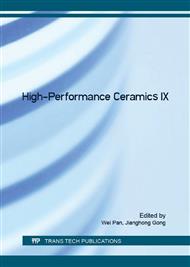[1]
W. J. Choyke, H. Matsunami and G. Pensl, Springer-Verlag, Silicon Carbide: Recent Major Advances, Berlin, (2004).
DOI: 10.1007/978-3-642-18870-1
Google Scholar
[2]
H. Zhang, L. M. Tolbert and B. Ozpineci, Impact of SiC Devices on Hybrid Electric and Plug-In Hybrid Electric Vehicles, IEEE Trans. Ind. Appl. 47(2) (2011) 912-921.
DOI: 10.1109/tia.2010.2102734
Google Scholar
[3]
Y. Katoh, L. L. Snead, I. Szlufarska and W. J. Weber, Radiation effects in SiC for nuclear structural applications, Curr. Opin. Solid State Mat. Sci. 16(3) (2012) 143-152.
DOI: 10.1016/j.cossms.2012.03.005
Google Scholar
[4]
E. Rauls, Z. Hajnal, P. Deak and T. Frauenheim, Theoretical study of the nonpolar surfaces and their oxygen passivation in 4H- and 6H-SiC, Phys. Rev. B. 64(24) (2001).
Google Scholar
[5]
T. Umeda, N. T. Son, J. Isoya, et al., Identification of the carbon antisite-vacancy pair in 4H-SiC, Phys. Rev. Lett. 96(14) (2006).
Google Scholar
[6]
N. T. Son, P. Carlsson, J. ul Hassan, E. Janzen, T. Umeda, J. Isoya, A. Gali, M. Bockstedte, N. Morishita, T. Ohshima and H. Itoh, Divacancy in 4H-SiC, Phys. Rev. Lett. 96(5) (2006).
DOI: 10.1103/physrevlett.96.055501
Google Scholar
[7]
T. C. Cai, Z. Z. Jia, B. M. Yan, D. P. Yu and X. S. Wu, Hydrogen assisted growth of high quality epitaxial graphene on the C-face of 4H-SiC, Appl. Phys. Lett. 106(1) (2015).
DOI: 10.1063/1.4905453
Google Scholar
[8]
G. W. Liu, M. L. Muolo, F. Valenza and A. Passerone, Survey on wetting of SiC by molten metals, Ceram. Int. 36(4) (2010) 1177-1188.
DOI: 10.1016/j.ceramint.2010.01.001
Google Scholar
[9]
T. Lingner, S. Greulich-Weber, et al., Structure of the silicon vacancy in 6H-SiC after annealing identified as the carbon vacancy-carbon antisite pair, Phys. Rev. B. 64(24) (2001).
DOI: 10.1103/physrevb.64.245212
Google Scholar
[10]
L. Li and I. S. T. Tsong, Atomic structures of 6H-SiC (0001) and (0001) surfaces, Surface Science. 351(1-3) (1996) 141-148.
DOI: 10.1016/0039-6028(95)01355-5
Google Scholar
[11]
J. Olander and K. Larsson, Influence of adsorbed species on the reconstruction of 4H-SiC(0001) surfaces, J. Phys. Chem. B. 105(32) (2001) 7619-7623.
DOI: 10.1021/jp010499z
Google Scholar
[12]
J. Pollmann, P. Krueger and M. Sabisch, Atomic and Electronic Structure of SiC Surface from ab-initio Calculations, Physica Status Solidi (B): Basic Research. 202(1) (1997) 421-421.
DOI: 10.1002/1521-3951(199707)202:1<421::aid-pssb421>3.0.co;2-d
Google Scholar
[13]
U. Starke, Atomic Structure of Hexagonal SiC Surfaces, Physica Status Solidi (B): Basic Research. 202(1) (1997) 475-475.
DOI: 10.1002/1521-3951(199707)202:1<475::aid-pssb475>3.0.co;2-e
Google Scholar
[14]
P. E. Blochl, Projector augmented–wave methods, Phys. Rev. B. 50 (1994) 17953-17979.
DOI: 10.1103/physrevb.50.17953
Google Scholar
[15]
G. Kresse, J. Furthumuller, Efficient iterative schenes for ab initio total-energy calculations using a plane-wave basis set, Phys. Rev. B. 54(1996) 11169-11186.
DOI: 10.1103/physrevb.54.11169
Google Scholar
[16]
J. P. Perdew, K. Burke and M. Ernzerhof, Generalized gradient approximation made simple. Phys. Rev. Lett. 77(1996) 3865-3868.
DOI: 10.1103/physrevlett.77.3865
Google Scholar
[17]
G. Kresse, D. Joubert, From ultrasoft pseudopotentials to the projector augmented-wave methods, Phys. Rev. B. 59(1999) 1758-1775.
DOI: 10.1103/physrevb.59.1758
Google Scholar
[18]
M. Sabisch, P. Krüger and J. Pollmann, Ab initio calculations of structural and electronic properties of 6H-SiC(0001) surfaces, Phys. Rev. B. 55(16) (1997) 10561-10570.
DOI: 10.1103/physrevb.55.10561
Google Scholar
[19]
F. Bernardini, A. Mattoni and L. Colombo, Energetics of native point defects in cubic silicon carbide, Eur. Phys. J. B. 38(3) (2004) 437-444.
DOI: 10.1140/epjb/e2004-00137-6
Google Scholar
[20]
L. Ji, C. Tang, L. Z. Sun and J. X. Zhong, Nucleation effect of Sia of 6H-SiC-(0001)-(Ö3xÖ3) R30° surface: First-principles study, Physica B. 405(17) (2010) 3576-3580.
DOI: 10.1016/j.physb.2010.05.043
Google Scholar
[21]
J. Olander and K. Larsson, Influence of adsorbed species on the reconstruction of 4H-SiC(0001) surfaces, J. Phys. Chem. B. 105(32) (2001) 7619-7623.
DOI: 10.1021/jp010499z
Google Scholar


